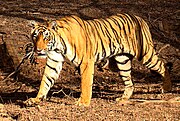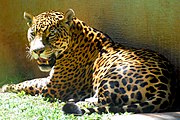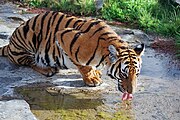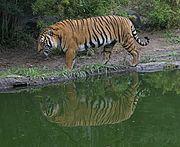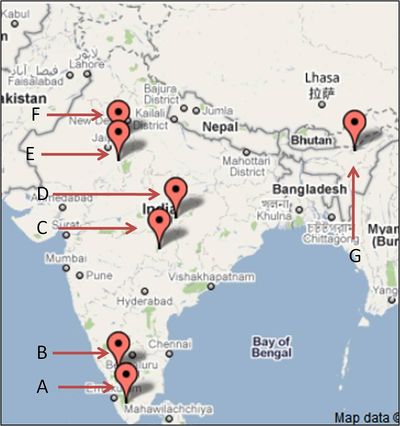Education:Tigers Quiz
Thanks to Anagh Purandare for creating this quiz
Tigers Quiz
<quiz display=simple>
{ What is the scientific name of Tiger?| type="()"} + Panthera tigris
|| Correct answer- Panthera leo
||- Acinonyx jubatus
||- Panthera onca
||
{Till very recently, how many subspecies of Tiger existed around the world?
| type="()"}
- 5
- 6
- 8
+ 9
|| There were 9 recent subspecies of tiger, out of which 3 are now extinct. These extinct subspecies include -Bali Tiger (Panthera tigris balica), Javan tiger (Panthera tigris sondaica) and Caspian Tiger (formerly Panthera tigris virgata)
{Which is the largest subspecies of Tiger by abundance? | type="()"} - South China Tiger
||+ Bengal Tiger
|| The recent tiger census showed that there are only 1400 tigers left in India. Natural distribution of Bengal tiger is in India. The different tiger subspecies have been defined based on their sizes, habitat preferences and prey they tend to catch.- Indochinese Tiger
||- Siberian Tiger
||{Which of the following regions is the smallest living subspecies of Tiger?
| type="()"}
- Siberian Tiger
- South-China Tiger
- Bengal Tiger
+ Sumatran Tiger
|| Sumatran tiger is critically endangered subspecies of tiger only found in Island of Sumatra in Indonesia. Male Sumatran tigers average 204 cm (6 feet, 8 inches) in length from head to tail and weigh about 136 kg (300 lb). Females average 198 cm (6 feet, 6 inches) in length and weigh about 91 kg (200 lb). '
{True or False: Tigers show sexual dimorphism | type="()"} + True || As name indicated sexual dimorphism means morphological differences between two sexes. Usually, all cats including show sexual dimorphism. Males in tigers are around 40% heavier than females. - False
{Identify the correct pugmark of a Tiger from the following pictures (Images obtained from this document by WWF India) | type="()"}
+|| This is the correct answer. Rest of them belong to dog family. Observe the presence of claws in the pugmark. Actually, this is a typical cat family pugmark. As cats, unlike dogs have retractable claws, claws are missing from the pugmarks. Images obtained from this document by WWF India
- - -
{Which of following features help us to identify individual tigers?
| type="()"}
- Shape of ears
+ Stripes on body
|| Tiger stripes not only help it to camouflage while hunting by breaking the continuity of its shape they are also unique to each individual. They are like figure prints of humans. One can identify individual tiger based on the pattern of these stripes on the body. Due to this feature, it is also easy to estimate tiger population in an area by using photographs with the help of well established technique of Capture-recapture method.
- Shape of face
- Length of tail
{When did the Government of India initiate Project Tiger? | type="()"} + 1973 || When Indira Gandhi was prime minister of Government of India, Her government launched Project Tiger in 1973 to protect this national animal. For details click here - 1972 - 1947 - 1983
{How many tiger reserves are governed by Project Tiger?
| type="()"}
- 29
- 10
+ 38
|| A full list can be obtained by clicking here
- 43
| type="{}"} Marker A is { Periyar|periyar_10} National park. Marker B is { Bandipur|bandipur_10} Tiger Reserve. Marker C is { Tadoba|tadoba|tadoba andhari|Tadoba Andhari_25} National park. Marker D is { Kanha|kanha_10} National park. Marker E is { Ranthambore|ranthambore|Ranathambore|ranathambore_15} National park. Marker F is { Sariska|sariska_10} National park. Marker G is { Kaziranga|kaziranga_10} National park.
{Which of the following information about a tiger can not be obtained from its scats? | type="()"} + Age of the animal || This is the correct answer. Rest of the information could be obtained from scats. Usually, diet of animal could be found based on hair or prey present in the scat. When scat is formed, it usually is covered with layer of mucus and few cells from lower intestine of animal. Animal’s DNA could be extracted from this outer layer of scat and sex and genetic identity of animal could be established based on well established technique of PCR (Polymerase chain reaction). - Sex of the animal - Genetic identity of animal - Diet of the animal
{What is average home range size of Bengal tiger male? Check correct answer!!!!! | type="()"} - 20 -40 square Km. - 30-50 square Km. - 60-100 square Km. + 10-30 square Km. || Usually tiger home range is decided by prey availability. But in case of male tigers, it is also influenced by availability of females. Usually a male tiger rage encompasses many female home ranges. The study of home ranges and its sizes are usually done using radio-telemetry. Find out more details about this here
</quiz>

